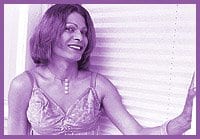When you’re the newest young thing on the gay scene, Pride is more than a parade: It’s the coming-out party of a lifetime. For Colours – a relatively unknown but growing queer Latin-Caribbean group – it’s got to be good. But with a budget smaller than what many non-profit organizations call lunch money, it’s always a bit of a challenge making things, well, float.
The three-month-old group has little more than $1,000 in the bank, a figure likely to be wiped out by Pride expenses (although the Pride Committee has waived their entrance fee, Colours says). But deep pockets or not, they’re approaching the final Sunday in June well-prepared and on schedule.
“We have the carnival spirit,” says Colour’s entertainment coordinator Jose Henry, “and nothing or nobody is going to let us down.”
That translates the truck rental, professional DJ and plenty of outrageous costumes á la Vegas-showgirl, with all the trimmings: brilliantly dyed plumage and flashy, multi-coloured sequins.
The group says this is the first time the Latin and Caribbean communities in Toronto have been fused onto one spectacular float during the parade. Colours member Lezlie Lee Kam calls this part of “the building up of Pride,” getting more people of colour into the parade. After all, she points out, it was only in 1992 that the first black organization joined in.
Although Colours’ mandate is to support Latin and Caribbean men and women new to Canada, most of their effort lately has been centered on making a splash at Pride, for the simple fact that it’s unbeatable advertizing.
“It’ll get the members of our community to realize there is an alternative,” says founding member Yasmeen McKenzie, who came from Trinidad three years ago. “It’s tremendous exposure.”
It’s also a tremendous opportunity to bond with similar groups. Only three weeks before Pride, Colours and Pelau – a queer group for people of colour – decided to march down the parade route, one in front of the other.
Colours organizers say that a spot in the parade will mean a chance to reach those men and women of Latin and Caribbean descent in the same unfortunate shoes McKenzie herself filled before Colours: feeling alienated and scared.
When McKenzie came to Toronto she was “virtually alone,” a situation exacerbated by her decision to transition (she was born Chris Prasad). What support she did find wasn’t a great fit.
“I joined ACAS [Asian Community AIDS Services] because it was the closest thing I could find to my cultural background.” Feeling marginalized and despondent, she quit.
She’s picked up a bit of what she’s learned at ACAS, and says that Colours tries to promote safe sex among its growing membership roster. Sex ed is needed within the group because, she remarks, none of the safe-sex organizations currently in Toronto are geared specifically to Latin or Caribbean newcomers. “First there’s a language problem. I also think Latin or Caribbean newcomers feel more of a sense of closeness with us, because we’ve already been through that whole process, so they can relate to us much better.”
Colours is hoping its participation in the parade will also attract the attention of more men like Ruben, a 22-year-old refugee who recently joined the group.
Ruben, speaking through an English translator, recounts how he was harassed at his construction job in his native land for being gay before finally being fired after his boss learned he was in a gay club the same night it was raided by police. In Canada for only one year, he has found work in a factory where his coworkers “probably know” about his homosexuality but “don’t make such a big deal out of it.”
Colours hopes soon to help Ruben obtain and sort through the paperwork so that he can stay in Canada legally.
Colours will readily accept anybody – even straight single moms, of which they have one – into its fold.
* Colours hosts a fundraising party night at the Red Spot (459 Church St) every third Saturday of the month; cover is $5 – the next installment is Jun 15.

 Why you can trust Xtra
Why you can trust Xtra


